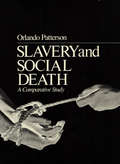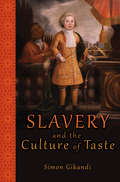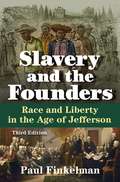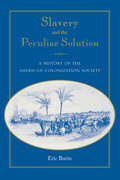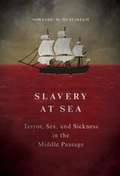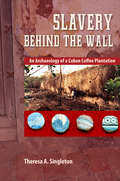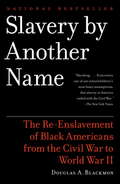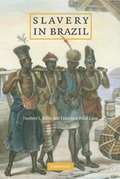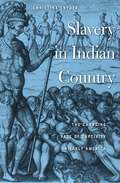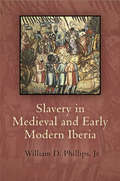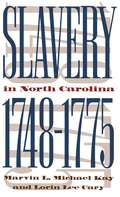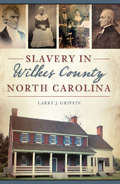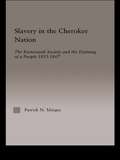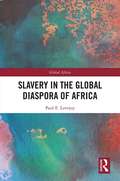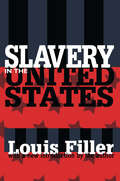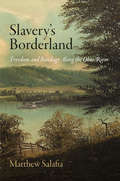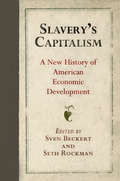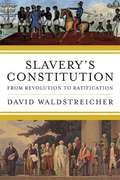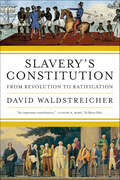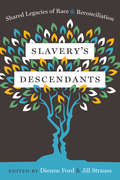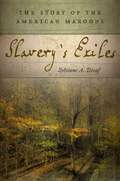- Table View
- List View
Slavery and Slaving in African History
by Sean StilwellThis book is a comprehensive history of slavery in Africa from the earliest times to the end of the twentieth century, when slavery in most parts of the continent ceased to exist. It connects the emergence and consolidation of slavery to specific historical forces both internal and external to the African continent. Sean Stilwell pays special attention to the development of settled agriculture, the invention of kinship, 'big men' and centralized states, the role of African economic production and exchange, the interaction of local structures of dependence with the external slave trades (transatlantic, trans-Saharan, Indian Ocean), and the impact of colonialism on slavery in the twentieth century. He also provides an introduction to the central debates that have shaped current understanding of slavery in Africa. The book examines different forms of slavery that developed over time in Africa and introduces readers to the lives, work, and struggles of slaves themselves.
Slavery and Social Death
by Orlando PattersonThis is the first full-scale comparative study of the nature of slavery. In a work of prodigious scholarship and enormous breadth, which draws on the tribal, ancient, premodern, and modern worlds, Orlando Patterson discusses the internal dynamics of slavery in sixty-six societies over time. These include Greece and Rome, medieval Europe, China, Korea, the Islamic kingdoms, Africa, the Caribbean islands, and the American South. Slavery is shown to be a parasitic relationship between master and slave, invariably entailing the violent domination of a natally alienated, or socially dead, person. The phenomenon of slavery as an institution, the author argues, is a single process of recruitment, incorporation on the margin of society, and eventual manumission or death. Distinctions abound in this work. Beyond the reconceptualization of the basic master-slave relationship and the redefinition of slavery as an institution with universal attributes, Patterson rejects the legalistic Roman concept that places the "slave as property" at the core of the system. Rather, he emphasizes the centrality of sociological, symbolic, and ideological factors interwoven within the slavery system. Along the whole continuum of slavery, the cultural milieu is stressed, as well as political and psychological elements. Materialistic and racial factors are deemphasized. The author is thus able, for example, to deal with "elite" slaves, or even eunuchs, in the same framework of understanding as fieldhands; to uncover previously hidden principles of inheritance of slave and free status; and to show the tight relationship between slavery and freedom. Interdisciplinary in its methods, this study employs qualitative and quantitative techniques from all the social sciences to demonstrate the universality of structures and processes in slave systems and to reveal cross-cultural variations in the slave trade and in slavery, in rates of manumission, and in the status of freedmen. Slavery and Social Death lays out a vast new corpus of research that underpins an original and provocative thesis.
Slavery and Social Death: A Comparative Study, With a New Preface
by Orlando Patterson<p>This is the first full-scale comparative study of the nature of slavery. In a work of prodigious scholarship and enormous breadth, which draws on the tribal, ancient, premodern, and modern worlds, Orlando Patterson discusses the internal dynamics of slavery in sixty-six societies over time. These include Greece and Rome, medieval Europe, China, Korea, the Islamic kingdoms, Africa, the Caribbean islands, and the American South. Slavery is shown to be a parasitic relationship between master and slave, invariably entailing the violent domination of a natally alienated, or socially dead, person. The phenomenon of slavery as an institution, the author argues, is a single process of recruitment, incorporation on the margin of society, and eventual manumission or death. <p>Distinctions abound in this work. Beyond the reconceptualization of the basic master-slave relationship and the redefinition of slavery as an institution with universal attributes, Patterson rejects the legalistic Roman concept that places the "slave as property" at the core of the system. Rather, he emphasizes the centrality of sociological, symbolic, and ideological factors interwoven within the slavery system. Along the whole continuum of slavery, the cultural milieu is stressed, as well as political and psychological elements. Materialistic and racial factors are deemphasized. The author is thus able, for example, to deal with "elite" slaves, or even eunuchs, in the same framework of understanding as fieldhands; to uncover previously hidden principles of inheritance of slave and free status; and to show the tight relationship between slavery and freedom. <p>Interdisciplinary in its methods, this study employs qualitative and quantitative techniques from all the social sciences to demonstrate the universality of structures and processes in slave systems and to reveal cross-cultural variations in the slave trade and in slavery, in rates of manumission, and in the status of freedmen. Slavery and Social Death lays out a vast new corpus of research that underpins an original and provocative thesis.</p>
Slavery and the Culture of Taste
by Simon GikandiIt would be easy to assume that, in the eighteenth century, slavery and the culture of taste--the world of politeness, manners, and aesthetics--existed as separate and unequal domains, unrelated in the spheres of social life. But to the contrary, Slavery and the Culture of Taste demonstrates that these two areas of modernity were surprisingly entwined. Ranging across Britain, the antebellum South, and the West Indies, and examining vast archives, including portraits, period paintings, personal narratives, and diaries, Simon Gikandi illustrates how the violence and ugliness of enslavement actually shaped theories of taste, notions of beauty, and practices of high culture, and how slavery's impurity informed and haunted the rarified customs of the time. Gikandi focuses on the ways that the enslavement of Africans and the profits derived from this exploitation enabled the moment of taste in European--mainly British--life, leading to a transformation of bourgeois ideas regarding freedom and selfhood. He explores how these connections played out in the immense fortunes made in the West Indies sugar colonies, supporting the lavish lives of English barons and altering the ideals that defined middle-class subjects. Discussing how the ownership of slaves turned the American planter class into a new aristocracy, Gikandi engages with the slaves' own response to the strange interplay of modern notions of freedom and the realities of bondage, and he emphasizes the aesthetic and cultural processes developed by slaves to create spaces of freedom outside the regimen of enforced labor and truncated leisure. Through a close look at the eighteenth century's many remarkable documents and artworks, Slavery and the Culture of Taste sets forth the tensions and contradictions entangling a brutal practice and the distinctions of civility.
Slavery and the Enlightenment in the British Atlantic, 1750-1807
by Justin RobertsThis book examines the daily details of slave work routines and plantation agriculture in the eighteenth-century British Atlantic, focusing on case studies of large plantations in Barbados, Jamaica, and Virginia. Work was the most important factor in the slaves' experience of the institution. Slaves' day-to-day work routines were shaped by plantation management strategies that drew on broader pan-Atlantic intellectual and cultural principles. Although scholars often associate the late eighteenth-century Enlightenment with the rise of notions of liberty and human rights and the dismantling of slavery, this book explores the dark side of the Enlightenment for plantation slaves. Many planters increased their slaves' workloads and employed supervisory technologies to increase labor discipline in ways that were consistent with the process of industrialization in Europe. British planters offered alternative visions of progress by embracing restrictions on freedom and seeing increasing labor discipline as central to the project of moral and economic improvement.
Slavery and the Founders: Race and Liberty in the Age of Jefferson
by Paul FinkelmanIn Slavery and the Founders, Paul Finkelman addresses a central issue of the American founding: how the first generation of leaders of the United States dealt with the profoundly important question of human bondage. The book explores the tension between the professed idea of America as stated in the Declaration of Independence, and the reality of the early American republic, reminding us of the profound and disturbing ways that slavery affected the U.S. Constitution and early American politics. It also offers the most important and detailed short critique of Thomas Jefferson's relationship to slavery available, while at the same time contrasting his relationship to slavery with that of other founders. This third edition of Slavery and the Founders incorporates a new chapter on the regulation and eventual (1808) banning of the African slave trade.
Slavery and the Peculiar Solution: A History of the American Colonization Society (Southern Dissent)
by Eric Burin"An exceptional work that will stand for years as the best study of the African colonization movement. Burin's insights into this often misunderstood idea will be appreciated by all historians of the early national era. The research, both archival and secondary, is excellent."--Douglas Egerton, Le Moyne College "Burin adds significantly to our understanding of the world view of slaveholding colonizationists, of their negotiations with prospectively freed people, and of their struggle with proslavery critics of colonization. . . . Historians of proslavery thought will find new ideas and information here."--Torrey Stephen Whitman, Mount St. Mary’s College From the early 1700s through the late 1800s, many whites advocated removing blacks from America. The American Colonization Society (ACS) epitomized this desire to deport black people. Founded in 1816, the ACS championed the repatriation of black Americans to Liberia in West Africa. Supported by James Madison, James Monroe, Henry Clay, and other notables, the ACS sent thousands of black emigrants to Liberia. In examining the ACS’s activities in America and Africa, Eric Burin assesses the organization’s impact on slavery and race relations. Burin focuses on ACS manumissions—that is, instances wherein slaves were freed on the condition that they go to Liberia. In doing so, he provides the first account of the ACS that covers the entire South throughout the antebellum era. He investigates everyone involved in the society’s affairs, from the emancipators and freedpersons at the center to the colonization agents, free blacks, southern jurists, newspaper editors, neighboring whites, proslavery ideologues, northern colonizationists, and abolitionists on the periphery. In mixing a panoramic view of ACS operations with close-ups on individual participants, Burin presents a unique, bifocal perspective on the ACS. Although colonization leaders initially envisioned their program as a pacific enterprise, in reality the push-and-pull among emancipators, freedpersons, and others rendered ACS manumissions logistically complex, financially troublesome, legally complicated, and at times socially disruptive enterprises. Like pebbles dropped in water, ACS manumissions rippled outward, destabilizing slavery in their wake. Based on extensive archival research and a database of 11,000 ACS emigrants, Burin’s study offers new insights concerning the origins, intentions, activities, and fate of the colonization movement.
Slavery and the Politics of Place
by Elizabeth A. BohlsGeography played a key role in Britain's long national debate over slavery. Writers on both sides of the question represented the sites of slavery - Africa, the Caribbean, and the British Isles - as fully imagined places and the basis for a pro- or anti-slavery political agenda. With the help of twenty-first-century theories of space and place, Elizabeth A. Bohls examines the writings of planters, slaves, soldiers, sailors, and travellers whose diverse geographical and social locations inflect their representations of slavery. She shows how these writers use discourses of aesthetics, natural history, cultural geography, and gendered domesticity to engage with the slavery debate. Six interlinked case studies, including Scottish mercenary John Stedman and domestic slave Mary Prince, examine the power of these discourses to represent the places of slavery, setting slaves' narratives in dialogue with pro-slavery texts, and highlighting in the latter previously unnoticed traces of the enslaved.
Slavery at Sea: Terror, Sex, and Sickness in the Middle Passage
by Sowande M MustakeemMost times left solely within the confine of plantation narratives, slavery was far from a land-based phenomenon. This book reveals for the first time how it took critical shape at sea. Expanding the gaze even more widely, the book centers on how the oceanic transport of human cargoes--known as the infamous Middle Passage--comprised a violently regulated process foundational to the institution of bondage. Sowande' Mustakeem's groundbreaking study goes inside the Atlantic slave trade to explore the social conditions and human costs embedded in the world of maritime slavery. Mining ship logs, records and personal documents, Mustakeem teases out the social histories produced between those on traveling ships: slaves, captains, sailors, and surgeons. As she shows, crewmen manufactured captives through enforced dependency, relentless cycles of physical, psychological terror, and pain that led to the making--and unmaking--of enslaved Africans held and transported onboard slave ships. Mustakeem relates how this process, and related power struggles, played out not just for adult men, but also for women, children, teens, infants, nursing mothers, the elderly, diseased, ailing, and dying. As she does so, she offers provocative new insights into how gender, health, age, illness, and medical treatment intersected with trauma and violence transformed human beings into the most commercially sought commodity for over four centuries.
Slavery behind the Wall: An Archaeology of a Cuban Coffee Plantation (Cultural Heritage Studies)
by Theresa A. Singleton"A significant contribution in Caribbean archaeology. Singleton weaves archaeological and documentary evidence into a compelling narrative of the lives of the enslaved at Santa Ana de Biajacas."--Patricia Samford, author of Subfloor Pits and the Archaeology of Slavery in Colonial Virginia "Presents results of the first historical archaeology in Cuba by an American archaeologist since the 1950s revolution. Singleton's extensive historical research provides rich context for this and future archaeological investigations, and the entire body of her pioneering research provides comparative material for other studies of African American life and institutional slavery in the Caribbean and the Americas."--Leland Ferguson, author of God's Fields: Landscape, Religion, and Race in Moravian Wachovia "Singleton's enlightening findings on plantation slavery life will undoubtedly constitute a reference point for future studies on Afro-Cuban archaeology."--Manuel Barcia, author of The Great African Slave Revolt of 1825: Cuba and the Fight for Freedom in Matanzas Cuba had the largest slave society of the Spanish colonial empire. At Santa Ana de Biajacas the plantation owner sequestered slaves behind a massive masonry wall. In the first archaeological investigation of a Cuban plantation by an English speaker, Theresa Singleton explores how elite Cuban planters used the built environment to impose a hierarchical social order upon slave laborers. Behind the wall, slaves reclaimed the space as their own, forming communities, building their own houses, celebrating, gambling, and even harboring slave runaways. What emerged there is not just an identity distinct from other North American and Caribbean plantations, but a unique slave culture that thrived despite a spartan lifestyle. Singleton's study provides insight into the larger historical context of the African diaspora, global patterns of enslavement, and the development of Cuba as an integral member of the larger Atlantic World.
Slavery by Another Name: The Re-Enslavement of Black Americans from the Civil War to World War II
by Douglas A. BlackmonThis groundbreaking historical expose unearths the lost stories of enslaved persons and their descendants who journeyed into freedom after the Emancipation Proclamation and then back into the shadow of involuntary servitude shortly thereafter in &“The Age of Neoslavery.&”By turns moving, sobering, and shocking, this unprecedented Pulitzer Prize-winning account reveals the stories of those who fought unsuccessfully against the re-emergence of human labor trafficking, the companies that profited most from neoslavery, and the insidious legacy of racism that reverberates today.Following the Emancipation Proclamation, convicts—mostly black men—were &“leased&” through forced labor camps operated by state and federal governments. Using a vast record of original documents and personal narratives, Douglas A. Blackmon brings to light one of the most shameful chapters in American history.&“An astonishing book. . . . It will challenge and change your understanding of what we were as Americans—and of what we are.&” —Chicago Tribune
Slavery in Brazil
by Herbert S. Klein Francisco Vidal LunaBrazil was the American society that received the largest contingent of African slaves in the Americas and the longest lasting slave regime in the Western Hemisphere. This is the first complete modern survey of the institution of slavery in Brazil and how it affected the lives of enslaved Africans. It is based on major new research on the institution of slavery and the role of Africans and their descendants in Brazil. Although Brazilians have incorporated many of the North American debates about slavery, they have also developed a new set of questions about slave holding: the nature of marriage, family, religion, and culture among the slaves and free colored; the process of manumission; and the rise of the free colored class during slavery. It is the aim of this book to introduce the reader to this latest research, both to elucidate the Brazilian experience and to provide a basis for comparisons with all other American slave systems.
Slavery in Indian Country
by Christina SnyderSlavery existed in North America long before the first Africans arrived at Jamestown in 1619. For centuries, from the pre-Columbian era through the 1840s, Native Americans took prisoners of war and killed, adopted, or enslaved them. Christina Snyder's pathbreaking book takes a familiar setting for bondage, the American South, and places Native Americans at the center of her engrossing story. Indian warriors captured a wide range of enemies, including Africans, Europeans, and other Indians. Yet until the late eighteenth century, age and gender more than race affected the fate of captives. As economic and political crises mounted, however, Indians began to racialize slavery and target African Americans. Native people struggling to secure a separate space for themselves in America developed a shared language of race with white settlers. Although the Indians' captivity practices remained fluid long after their neighbors hardened racial lines, the Second Seminole War ultimately tore apart the inclusive communities that Native people had created through centuries of captivity. Snyder's rich and sweeping history of Indian slavery connects figures like Andrew Jackson and Cherokee chief Dragging Canoe with little-known captives like Antonia Bonnelli, a white teenager from Spanish Florida, and David George, a black runaway from Virginia. Placing the experiences of these individuals within a complex system of captivity and Indians' relations with other peoples, Snyder demonstrates the profound role of Native American history in the American past.
Slavery in Medieval and Early Modern Iberia
by William D. Phillips Jr.The enslaved population of medieval Iberia composed only a small percentage of the general populace at any given point, and slave labor was not essential to the regional economy during the period. Yet slaves were present in Iberia from the beginning of recorded history until the early modern era, and the regulations and norms for slavery and servitude shifted as time passed and kingdoms rose and fell. The Romans brought their imperially sanctioned forms of slavery to the Iberian peninsula, and these were adapted by successive Christian kingdoms during the Middle Ages. The Muslim conquest of Iberia introduced new ideas about slavery and effected an increase in slave trade. During the later Middle Ages and the early modern period, slave owners in Christian Spain and Portugal maintained slaves at home, frequently captives taken in wars and sea raids, and exported their slave systems to colonies across the Atlantic.Slavery in Medieval and Early Modern Iberia provides a magisterial survey of the many forms of bound labor in Iberia from ancient times to the decline of slavery in the eighteenth century. William D. Phillips, Jr., examines the pecuniary and legal terms of slavery from purchase to manumission. He pays particular attention to the conditions of life for the enslaved, which, in a religiously diverse society, differed greatly for Muslims and Christians as well as for men and women. This sweeping narrative will become the definitive account of slavery in a place and period that deeply influenced the forms of forced servitude that shaped the New World.
Slavery in North Carolina, 1748-1775
by Lorin Lee Cary Marvin L. KayMichael Kay and Lorin Cary illuminate new aspects of slavery in colonial America by focusing on North Carolina, which has largely been ignored by scholars in favor of the more mature slave systems in the Chesapeake and South Carolina. Kay and Cary demonstrate that North Carolina's fast-growing slave population, increasingly bound on large plantations, included many slaves born in Africa who continued to stress their African pasts to make sense of their new world. The authors illustrate this process by analyzing slave languages, naming practices, family structures, religion, and patterns of resistance. Kay and Cary clearly demonstrate that slaveowners erected a Draconian code of criminal justice for slaves. This system played a central role in the masters' attempt to achieve legal, political, and physical hegemony over their slaves, but it impeded a coherent attempt at acculturation. In fact, say Kay and Cary, slaveowners often withheld white culture from slaves rather than work to convert them to it. As a result, slaves retained significant elements of their African heritage and therefore enjoyed a degree of cultural autonomy that freed them from reliance on a worldview and value system determined by whites.
Slavery in Wilkes County, North Carolina (American Heritage)
by Larry J. GriffinSlavery is a tragic chapter in the history of Wilkes County with a lasting legacy. Prominent businessmen and celebrated civic leaders, like General William Lenoir and William Pitt Waugh, were among the county’s largest slaveholders. Judith Williams Barber endured forty-five years of slavery and garnered respect from both white and black residents. Her story is linked to free person of color and noted landowner Henderson Waugh, whose illustrious, slaveholding white father connected the two families—one slave and the other free. Author Larry Griffin takes readers on an emotional journey to separate fact from myth as he chronicles the history of slavery in Wilkes County.
Slavery in the Cherokee Nation: The Keetoowah Society and the Defining of a People, 1855-1867 (Studies in African American History and Culture)
by Patrick Neal MingesThis work explores the dynamic issues of race and religion within the Cherokee Nation and to look at the role of secret societies in shaping these forces during the nineteenth century.
Slavery in the Global Diaspora of Africa (Global Africa)
by Paul E. LovejoyThe collective significance of the themes that are explored in Slavery in the Global Diaspora of Africa bridge the Atlantic and thereby provide insights into historical debates that address the ways in which parts of Africa fitted into the modern world that emerged in the Atlantic basin. The study explores the conceptual problems of studying slavery in Africa and the broader Atlantic world from a perspective that focuses on Africa and the historical context that accounts for this influence. Paul Lovejoy focuses on the parameters of the enforced migration of enslaved Africans, including the impact on civilian populations in Africa, constraints on migration, and the importance of women and children in the movement of people who were enslaved. The prevalence of slavery in Africa and the transformations of social and political formations of societies and political structures during the era of trans-Atlantic migration inform the book’s research. The analysis places Africa, specifically western Africa, at the center of historical change, not on the frontier or periphery of western Europe or the Americas, and provides a global perspective that reconsiders historical reconstruction of the Atlantic world that challenges the distortions of Eurocentrism and national histories. Slavery in the Global Diaspora of Africa will be of interest to scholars and students of colonial history, African history, Diaspora Studies, the Black Atlantic and the history of slavery.
Slavery in the United States
by Louis FillerSlavery in the United States clarifies the institution of slavery in its historical context. Filler avoids the all too prevalent literary attitude of either treating slavery as an unmitigated nightmare from the past, or regarding it as a way of life which warmly repaid slave and slaveholder. He does not reduce the issue to one of fact and figures, nor does he inject endless hypotheses and analogues. Rather, this finely etched volume encompasses the human implications of slavery and its practices. It emphasizes the distinguished and disreputable elements on both sides of the slavery relationship, and in every part of the United States.Slavery offers peculiar challenges to the student of American life, past and present. It is unrealistic to avoid the human implications of slavery and its practice. It is equally unhelpful to assume glib and partial viewpoints with respect to so all-embracing a system as slavery became. The cause of progress, no less than social science, is not advanced by indifference to patent facts. The civil libertarian who romanticizes black people indiscriminately, and lumps Jefferson Davis with Simon Legree may win popularity with enthusiasts and ideologues. But they will soon find themselves quaint and outmoded.The author reminds us that "the safest approach to slavery is to determine what the institution meant to the country at large; why it flourished as it did, and how it came to be opposed and overthrown." The work includes high quality often neglected readings that permit the reader to form his or her own views. It reveals the best writing on all aspects of the slavery issue, as well as analytic summations by contemporary historians and social researchers.
Slavery's Borderland
by Matthew SalafiaIn 1787, the Northwest Ordinance made the Ohio River the dividing line between slavery and freedom in the West, yet in 1861, when the Civil War tore the nation apart, the region failed to split at this seam. In Slavery's Borderland, historian Matthew Salafia shows how the river was both a physical boundary and a unifying economic and cultural force that muddied the distinction between southern and northern forms of labor and politics.Countering the tendency to emphasize differences between slave and free states, Salafia argues that these systems of labor were not so much separated by a river as much as they evolved along a continuum shaped by life along a river. In this borderland region, where both free and enslaved residents regularly crossed the physical divide between Ohio, Indiana, and Kentucky, slavery and free labor shared as many similarities as differences. As the conflict between North and South intensified, regional commonality transcended political differences. Enslaved and free African Americans came to reject the legitimacy of the river border even as they were unable to escape its influence. In contrast, the majority of white residents on both sides remained firmly committed to maintaining the river border because they believed it best protected their freedom. Thus, when war broke out, Kentucky did not secede with the Confederacy; rather, the river became the seam that held the region together.By focusing on the Ohio River as an artery of commerce and movement, Salafia draws the northern and southern banks of the river into the same narrative and sheds light on constructions of labor, economy, and race on the eve of the Civil War.
Slavery's Capitalism: A New History of American Economic Development
by Sven Beckert Seth RockmanDuring the nineteenth century, the United States entered the ranks of the world's most advanced and dynamic economies. At the same time, the nation sustained an expansive and brutal system of human bondage. This was no mere coincidence. Slavery's Capitalism argues for slavery's centrality to the emergence of American capitalism in the decades between the Revolution and the Civil War. According to editors Sven Beckert and Seth Rockman, the issue is not whether slavery itself was or was not capitalist but, rather, the impossibility of understanding the nation's spectacular pattern of economic development without situating slavery front and center. American capitalism--renowned for its celebration of market competition, private property, and the self-made man--has its origins in an American slavery predicated on the abhorrent notion that human beings could be legally owned and compelled to work under force of violence.Drawing on the expertise of sixteen scholars who are at the forefront of rewriting the history of American economic development, Slavery's Capitalism identifies slavery as the primary force driving key innovations in entrepreneurship, finance, accounting, management, and political economy that are too often attributed to the so-called free market. Approaching the study of slavery as the originating catalyst for the Industrial Revolution and modern capitalism casts new light on American credit markets, practices of offshore investment, and understandings of human capital. Rather than seeing slavery as outside the institutional structures of capitalism, the essayists recover slavery's importance to the American economic past and prompt enduring questions about the relationship of market freedom to human freedom.Contributors: Edward E. Baptist, Sven Beckert, Daina Ramey Berry, Kathryn Boodry, Alfred L. Brophy, Stephen Chambers, Eric Kimball, John Majewski, Bonnie Martin, Seth Rockman, Daniel B. Rood, Caitlin Rosenthal, Joshua D. Rothman, Calvin Schermerhorn, Andrew Shankman, Craig Steven Wilder.
Slavery's Constitution From Revolution to Ratification: From Revolution to Ratification
by David WaldstreicherTaking on decades of received wisdom, David Waldstreicher has written the first book to recognize slavery’s place at the heart of the U.S. Constitution. Famously, the Constitution never mentions slavery. And yet, of its eighty-four clauses, six were directly concerned with slaves and the interests of their owners. Five other clauses had implications for slavery that were considered and debated by the delegates to the 1787 Constitutional Convention and the citizens of the states during ratification. This “peculiar institution” was not a moral blind spot for America’s otherwise enlightened framers, nor was it the expression of a mere economic interest. Slavery was as important to the making of the Constitution as the Constitution was to the survival of slavery. By tracing slavery from before the revolution, through the Constitution’s framing, and into the public debate that followed, Waldstreicher rigorously shows that slavery was not only actively discussed behind the closed and locked doors of the Constitutional Convention, but that it was also deftly woven into the Constitution itself. For one thing, slavery was central to the American economy, and since the document set the stage for a national economy, the Constitution could not avoid having implications for slavery. Even more, since the government defined sovereignty over individuals, as well as property in them, discussion of sovereignty led directly to debate over slavery’s place in the new republic. Finding meaning in silences that have long been ignored, Slavery’s Constitution is a vital and sorely needed contribution to the conversation about the origins, impact, and meaning of our nation’s founding document.
Slavery's Constitution: From Revolution to Ratification
by David WaldstreicherTaking on decades of received wisdom, David Waldstreicher has written the first book to recognize slavery's place at the heart of the U.S. Constitution. Famously, the Constitution never mentions slavery. And yet, of its eighty-four clauses, six were directly concerned with slaves and the interests of their owners. Five other clauses had implications for slavery that were considered and debated by the delegates to the 1787 Constitutional Convention and the citizens of the states during ratification. This "peculiar institution" was not a moral blind spot for America's otherwise enlightened framers, nor was it the expression of a mere economic interest. Slavery was as important to the making of the Constitution as the Constitution was to the survival of slavery.By tracing slavery from before the revolution, through the Constitution's framing, and into the public debate that followed, Waldstreicher rigorously shows that slavery was not only actively discussed behind the closed and locked doors of the Constitutional Convention, but that it was also deftly woven into the Constitution itself. For one thing, slavery was central to the American economy, and since the document set the stage for a national economy, the Constitution could not avoid having implications for slavery. Even more, since the government defined sovereignty over individuals, as well as property in them, discussion of sovereignty led directly to debate over slavery's place in the new republic.Finding meaning in silences that have long been ignored, Slavery's Constitution is a vital and sorely needed contribution to the conversation about the origins, impact, and meaning of our nation's founding document.
Slavery's Descendants: Shared Legacies of Race and Reconciliation
by Jill StraussRace remains a potent and divisive force in our society. Whether it is the shooting of minority people by the police, the mass incarceration of people of color, or the recent KKK rallies that have been in the news, it is clear that the scars from the United States’ histories of slavery and racial discrimination run too deep to simply be ignored. But what are the most productive ways to deal with the toxic and torturous legacies of American racism? Slavery’s Descendants brings together contributors from a variety of racial backgrounds, all members or associates of a national racial reconciliation organization called Coming to the Table, to tell their stories of dealing with America’s racial past through their experiences and their family histories. Some are descendants of slaveholders, some are descendants of the enslaved, and many are descendants of both slaveholders and slaves. What they all have in common is a commitment toward collective introspection, and a willingness to think critically about how the nation’s histories of oppression continue to ripple into the present, affecting us all. The stories in Slavery’s Descendants deal with harrowing topics—rape, lynching, cruelty, shame—but they also describe acts of generosity, gratitude, and love. Together, they help us confront the legacy of slavery to reclaim a more complete picture of U.S. history, one cousin at a time. Funding for the production of this book was provided by Furthermore, a program of the J. M. Kaplan Fund (https://www.furthermore.org).
Slavery's Exiles: The Story of the American Maroons
by Sylviane A DioufSylviane A. Diouf&’s Slavery&’s Exiles reveals the forgotten stories of America maroons―wilderness settlers evading discovery after escaping slavery. Over more than two centuries men, women, and children escaped from slavery to make the Southern wilderness their home. They hid in the mountains of Virginia and the low swamps of South Carolina; they stayed in the neighborhood or paddled their way to secluded places; they buried themselves underground or built comfortable settlements. Known as maroons, they lived on their own or set up communities in swamps or other areas where they were not likely to be discovered. Although well-known, feared, celebrated or demonized at the time, the maroons whose stories are the subject of this book have been forgotten, overlooked by academic research that has focused on the Caribbean and Latin America. Who the American maroons were, what led them to choose this way of life over alternatives, what forms of marronage they created, what their individual and collective lives were like, how they organized themselves to survive, and how their particular story fits into the larger narrative of slave resistance are questions that this book seeks to answer. To survive, the American maroons reinvented themselves, defied slave society, enforced their own definition of freedom and dared create their own alternative to what the country had delineated as being black men and women&’s proper place. Audacious, self-confident, autonomous, sometimes self-sufficient, always self-governing; their very existence was a repudiation of the basic tenets of slavery. &“Impressive research and vivid prose. . . . An important addition to our understanding of slave society and black resistance.&” —Pulitzer Prize-winning author Eric Foner

